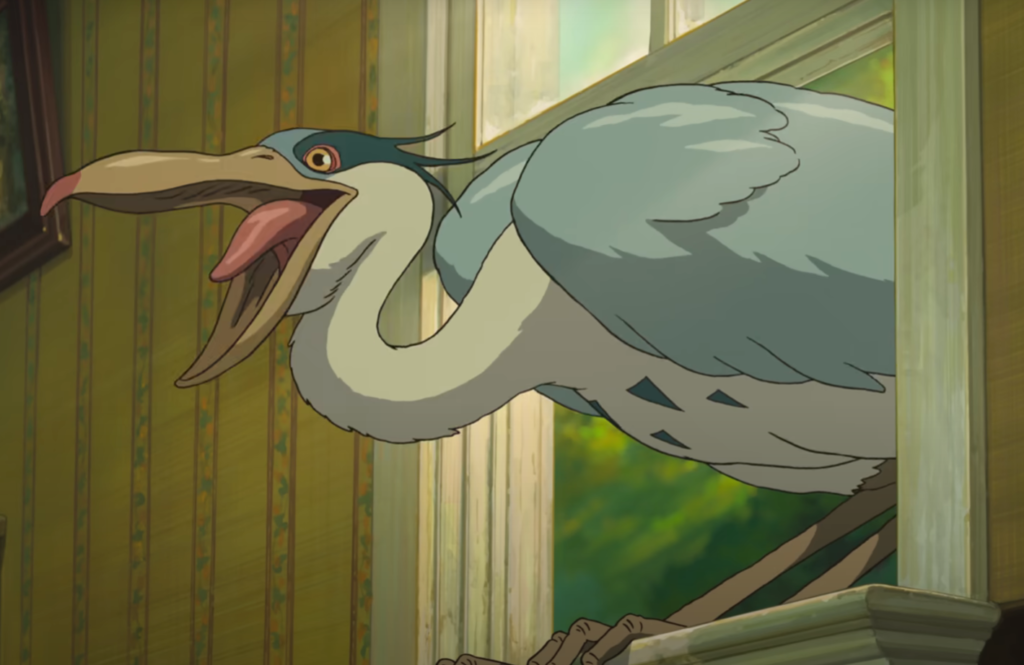12-year-old Mahito is distraught when his mother dies in a fire after an air raid on Tokyo. But to make matters worse, his father remarries his mother’s younger sister, and the whole family moves to the countryside. Feeling isolated and unsettled in a strange new household, Mahito finds himself drawn into a strange, fantastical world of talking birds and mysterious magic.
Remember when Hayao Miyazaki was going to retire after just one last project? That was many years ago, and yet here we are in 2024, watching his latest endeavour. One might hope that a lifetime of perfecting his craft would mean that we were guaranteed a masterpiece, but alas, far from it. What we get instead is an incoherent mess, lacking in both strong narrative and proper character development.
The movie starts out conventionally enough. Mahito loses his beloved mother, and not too long afterwards, he is forced to move to the countryside to live with his stepmother (who also happens to be his aunt) and a bunch of random old grannies. With Mahito’s father busy at his factory, and his stepmother already pregnant with his half-sibling, Mahito is understandably somewhat unhappy.
What I expected next was some sort of magical tale of friendship, whereupon Mahito befriended the titular heron, and experienced a world of wonder and delight that helped him overcome his family issues. What happens instead could arguably be described as such, but it’s more a tale of weirdness and incoherence. It turns out that the heron is a creepy talking goblin of some sort, and it lures Mahito to a bizarre fantasy world, where magic is real, and most of the inhabitants are sentient birds of one sort and another. There, Mahito’s goals are twofold – first, he wants to confirm the heron’s claim that his mother is still alive, and second, he needs to rescue his stepmother, who has also wandered into this world.
What follows feels very much like a fever dream. Characters show up specifically to rescue Mahito from whatever trouble he is in, only to retire from the narrative a few scenes later. Mahito wanders from one strange and perilous situation to another, with little grounding or explanation given as to what this fantasy world is, or why it behaves the way it does. Events feel more like a series of unconnected vignettes than a coherent narrative, to the point where I’d be unsurprised if it was later revealed that some scenes were edited together in the wrong order.
Amidst all this chaos, it’s hard to care about any of the characters. None of them have any emotional depth, and their feelings and reactions are implied rather than explored. It’s assumed that we know from having consumed prior media that children can feel awkward when a parent remarries, and so little effort is put into exploring Mahito’s relationship with his new stepmother. Even when character development does happen, it’s so rushed that it comes across as being purely for narrative convenience. Rather than seeing characters develop, grow, and shift their opinions organically, they will suddenly come out with things that contradict what they said mere moments before.
The Boy and the Heron is, therefore, not massively enjoyable as a viewing experience, but what it does offer is some insight into Miyazaki and his thoughts. Many Ghibli films are adapted from children’s fiction from around the world, but Mahito’s story is clearly based on Miyazaki’s own childhood. We’ve seen elements of this in prior Ghibli movies, such as ill relatives, World War II and a love of airplanes and flight, but never has it been so blatantly autobiographical as it is here.
But Mahito isn’t the only director stand-in in this movie. At the core of the film’s fantasy world lives Mahito’s ancestor, an old man who creates and directs the fantasy world – and who is desperate to hand over his work to his successor. How could this old man be anyone other than Miyazaki, who is himself in charge of so many fantasy worlds, and whose relationship with his own son and fellow director has always been somewhat rocky? Beneath all the randomness and incoherence of this movie, is it actually Miyazaki’s cry for help?
Plot issues aside, The Boy and the Heron manages to deliver to the expected standard when it comes to aesthetics. We all know Ghibli’s trademark visual style by now, and this movie fits right in with the rest of them. The animation is meticulous, perhaps overly so in places, and character designs do range into the grotesque at times, but this is nothing new from Ghibli. Joe Hisaishi also brings his usual talent to the musical score, which is well-orchestrated and adds to the ambience of the film.
Final Thoughts
Despite the studio’s stellar reputation, not every Ghibli movie is an unqualified hit. Much as we might like to lionise the abilities of Miyazaki and his studio, their latest outing is something of a disappointment. It’s worth seeing once, just to say you have, but unless you fancy repeated dives into Miyazaki’s psyche, I wouldn’t recommend rushing to rewatch it.
Tier: Bronze

